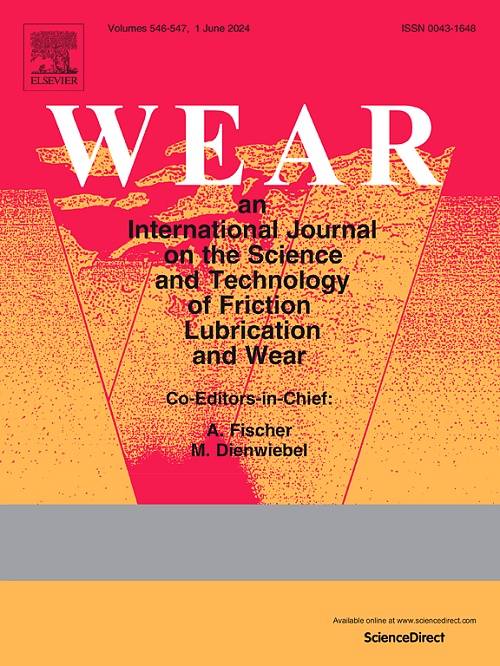MXenes (Ti3C2Tx)滴浇沉积对结构混凝土微动磨损的影响
IF 6.1
1区 工程技术
Q1 ENGINEERING, MECHANICAL
引用次数: 0
摘要
在土木工程中,混凝土是最广泛使用的材料,因为它的组成部分的可用性。半刚性结构体系的摩擦学研究在土木工程中具有重要意义,因为混凝土与金属元素之间的初始刚性接触会产生微运动,从而导致微动磨损和可能的裂缝。最近,一种名为MXenes的新型二维金属碳化物和氮化物纳米片在摩擦学应用中脱颖而出,因为它们具有层状结构,具有自润滑和增强性能,但它们成本高昂且难以大规模生产,这使得它们在土木工程中的应用具有挑战性,尽管文献中有令人鼓舞的结果。为了克服这一点,本研究提出通过滴铸(涉及非常少量的MXenes)来表面沉积MXenes,以控制混凝土和钢之间的微动磨损。用浓度约为0.4 mg/mL的MXenes分散液在异丙醇中沉积一份和五份应用液。在不同速度(0.2 mm/s和2 mm/s)和时间(5和30 min)下,对混凝土(有和没有MXenes沉积)在钢counterbodies上进行了总行程为200 μm的微动试验。结果表明,在微动试验中得到的摩擦系数在混凝土中使用Mxenes作为钢筋和浇筑时没有统计学上的显著差异。从微动试验中得到的磨损率表明,在较低的速度下,改性混凝土在5min和30min试验中没有明显的差异。另一方面,在速度= 2 mm/s,时间= 5 min的条件下,MXenes通过抛射一次应用的磨损率低于参考值。在更高的转速和30分钟的测试中,对磨损率的影响更大,这可能是接触中的摩擦化学效应的结果。很明显,在这种情况下,MXenes纳米片促进了碎片的团聚,部分地将它们转移到对偶体;形成的摩擦层可能促进了表面的平滑。通过扫描电镜(SEM)图像和表面形貌参数证实了这一点,特别是在MXenes应用1次后,表面更加光滑。在能量色散x射线(EDS)光谱中,1和5 MXenes应用的样品在轨迹中含有少量的钛,证实了MXenes纳米片参与了接触中的摩擦化学反应,有助于减少磨损。这些结果证明了MXene滴铸沉积的潜力,即使是少量的。本文章由计算机程序翻译,如有差异,请以英文原文为准。
Effects of MXenes (Ti3C2Tx) deposition by drop casting on the fretting wear of structural concrete
In civil engineering, concrete is the most widely used material due to the availability of its components. Research on tribology of semi-rigid structural systems is important in civil engineering, as the initially rigid contact between concrete and metallic elements can generate micromovement, resulting in wear due to fretting and possible cracks. Recently, a new family of 2D metal carbide and nitride nanosheets called MXenes has stood out in tribological applications due to their layered structure, which provides self-lubricating and reinforcing properties, but they are costly and difficult to produce in large scale, making their use in civil engineering challenging, despite encouraging results from the literature. To overcome this, the present work proposed surface deposition of MXenes by drop-casting (involving very small amounts of Mxenes) to control fretting wear between concrete and steel. One and five applications were deposited from a dispersion at a concentration of approximately 0.4 mg/mL of MXenes in isopropanol. Fretting tests were carried out on concrete (with and without MXenes deposition) against steel counterbodies for a total stroke of 200 μm under different speeds (0.2 and 2 mm/s) and times (5 and 30 min). The results showed that the friction coefficients obtained in the fretting tests did not present a statistically significant difference when using Mxenes either as a reinforcement in the concrete or deposited by drop casting. The wear rates obtained from the fretting tests demonstrated that, for the lower speed, no significant difference could be confirmed for the modified concretes in either the 5 min or the 30 min tests. On the other hand, in the condition of speed = 2 mm/s and time = 5 min, the wear rate for one application of MXenes by dropcasting was lower than the reference. With a higher speed and 30-min test, a greater effect on the wear rate occurred, which may be the result of tribochemical effects in the contact. It is clear that, in this case, the MXenes nanosheets promoted agglomeration of the debris, partially transferring them to the counterbody; the formed tribolayer probably promoted the smoothing of the surfaces. This was confirmed by means of scanning electron microscopy (SEM) images and topographic parameters of the surfaces, which showed a smoother surface, especially with 1 application of MXenes. In energy dispersive X-ray (EDS) spectra, samples with 1 and 5 MXenes applications contained small amounts of titanium in the tracks, confirming that the MXenes nanosheets participated of the tribochemical reactions in the contact, contributing to the reduction of wear. These results demonstrate the potential of MXene deposition by drop casting, even in small quantities.
求助全文
通过发布文献求助,成功后即可免费获取论文全文。
去求助
来源期刊

Wear
工程技术-材料科学:综合
CiteScore
8.80
自引率
8.00%
发文量
280
审稿时长
47 days
期刊介绍:
Wear journal is dedicated to the advancement of basic and applied knowledge concerning the nature of wear of materials. Broadly, topics of interest range from development of fundamental understanding of the mechanisms of wear to innovative solutions to practical engineering problems. Authors of experimental studies are expected to comment on the repeatability of the data, and whenever possible, conduct multiple measurements under similar testing conditions. Further, Wear embraces the highest standards of professional ethics, and the detection of matching content, either in written or graphical form, from other publications by the current authors or by others, may result in rejection.
 求助内容:
求助内容: 应助结果提醒方式:
应助结果提醒方式:


